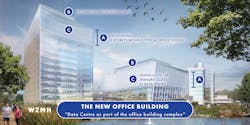Wasted energy from data centers could power nearby buildings
By John Caulfield, Senior Editor
Data centers are being built at a rate that could see the number of facilities double in the next decade. Their huge energy needs, left unaddressed, will pose a threat to the positive steps the built environment takes toward reducing its carbon footprint.
Toronto-based WZMH Architects has come up with a concept to harness “wasted energy” from data centers by diverting it to residences and commercial buildings that are located near the data center to form a direct current microgrid-based community.
The firm’s Innovation Lab has been conducting regular workshops on this topic with Ryerson University. And while WZMH hasn’t reached a proof-of-concept stage yet, “it wasn’t meant to,” says Zenon Radewych, a Principal with the firm. He believes, however, that it’s only a matter of time before a microgrid community is created.
“We’ve been living in a low-voltage DC [direct current] world for a long time,” he explains. The goal would be to build out the direct-current infrastructure and “push AC [alternating current] as far back as possible.” Radewych notes that DC is more compatible to green products like solar and wind, as well as to Internet of Things devices.
Here’s how the concept would work:
- Data center generators are tested monthly, but the energy from those tests isn’t used to support the facility’s electricity requirements, so it’s being wasted;
- Using DC microgrid technology and a battery storage system, the wasted energy from data centers could be harnessed to power nearby buildings;
- Buildings constructed around data centers would benefit from a free, reliable, and self-sustaining energy source. WZMH research estimates that in a data center with eight three-megawatt diesel generators that are tested for one hour per month, a DC microgrid can create energy equivalent to one day of power per week for a residential building with 125 units.
The microgrid—a localized network of electric loads and power sources—could function independently or in conjunction with a larger grid system. In WZMH’s concept, the microgrid would be an alternative power system in the building whose equipment could be energized by various energy-generating sources.
WZMH envisions the microgrid community with battery storage systems that, along with renewable energy sources and access to recycled energy from the data center, comprise the power plant for the co-located buildings within the community.
Radewych says that data centers have only scratched the surface when it comes to lowering their energy consumption. He also speculates that the data centers built nearer to residential and commercial properties would probably need to be constructed vertically because of land availability.
